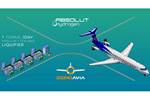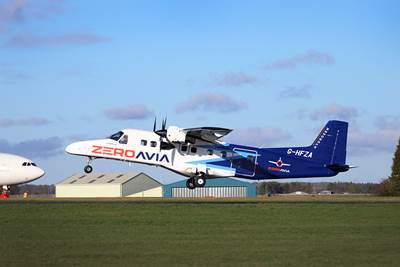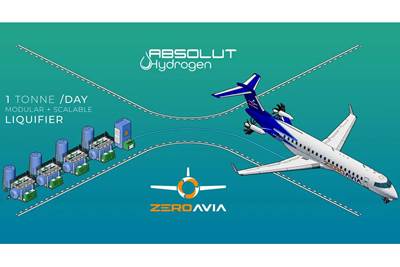ZeroAvia expands the reach of zero emissions flight technology
Electric motor technology from ZeroAvia for aviation applications is helping pave way for hydrogen-electric engines for Dash 8 and similar airframes.
Share
Read Next

Photo Credit: Getty Images
(Hollister, Calif., U.S.) was supplied with a Dash 8 Q400 regional turboprop by (Seattle, Wash., U.S.) to be retrofitted with a hydrogen-electric propulsion system in an effort to expand the reach and applicability of zero emissions flight technology. The aircraft was formally handed over to ZeroAvia by Alaska Airlines at an event held at ZeroAvia’s Paine Field research and development site.
When Alaska Airlines’ regional carrier Horizon Air retired its Q400 fleet, it reserved one of the aircraft for research and development purposes to further advance zero emissions technology for the aviation industry. The aircraft was repainted with a special livery to highlight the mission of the partnership.
A multi-megawatt modular electric motor system in a 1.8 MW protoype configuration was also shown by ZeroAvia at the event. It was demonstrated with a propeller spin aboard the ZeroAvia’s 15-ton HyperTruck ground-test rig. Combined with higher temperature PEM fuel cells and advanced power electronics — both technologies that ZeroAvia is developing in-house — the electric motor technology is one of three building blocks for enabling commercially-relevant hydrogen fuel cell engines for larger aircraft.
"This is a great step forward in aviation innovation, to help create a new future of flight — right here at home,” says Alaska Airlines CEO Ben Minicucci. “Alaska Airlines has defined a five-part journey to achieve net zero carbon emissions long-term, but we can’t get there alone. New technologies are required to make that future possible, and we’re thrilled to partner with industry leader ZeroAvia to make new zero emissions options a reality.”
Aligning ZeroAvia’s powertrain with the Dash 8-400, also known as the Q400, airframe is intended to represent a commercially viable, zero-emission aircraft with fuel cell engine technology around five times more powerful than what has been demonstrated elsewhere.
“Demonstrating this size of aircraft in flight, powered entirely by novel propulsion, would have been unthinkable a few years ago,” says Val Miftakhov, founder and CEO of ZeroAvia. “Launching this program puts us on track for a test flight next year, and accelerates our progress toward the future of zero-emission flight for Alaska Airlines and for the world at large.”
ZeroAvia’s developments not only light the way for a potential flight of the Q400, but they also demonstrate progress toward certification of the ZA2000 propulsion system. In January 2023, ZeroAvia flew a retrofitted 19-seat aircraft with its prototype 600kW hydrogen-electric engine (ZA600). This followed the demonstration flight of a 250kW system in 2020, which at the time of flight was the world’s largest aircraft flown using a novel zero-emission power source.
ZeroAvia’s hydrogen-electric engine uses fuel cells to generate electricity from hydrogen fuel, before using that electricity to power electric motors which turn the aircraft propellers. The certifiable ZA2000 system will include ZeroAvia’s High Temperature PEM fuel cells and liquid hydrogen fuel storage, integral to delivering the necessary energy density for commercial operations of large regional turboprops. The company has already established an engineering partnership with De Havilland of Canada, the original manufacturer of the Dash 8 family of aircraft to enable exchange of data and expertise with the airframe.
In 2021, Alaska Airlines launched a partnership and invested in ZeroAvia to support the development of zero emissions propulsion technology for regional aircraft. As the fifth largest U.S. airline with a large regional network, Alaska has an opportunity to support the development of zero-emissions propulsion technology for regional aircraft. By establishing the viability of regional-sized aircraft, both companies plan to advance zero-emissions technology across the industry.
Related Content
Plant tour: Hexagon Purus, Kassel, Germany
Fully automated, Industry 4.0 line for hydrogen pressure vessels advances efficiency and versatility in small footprint for next-gen, sustainable composites production.
Read MoreNew GTL breakthrough in composite tubing for liquid hydrogen in aircraft and space vehicles
Tests versus stainless steel tubing show 10 times faster chill down, fuel flow in 2 seconds and less boil-off for significantly faster fueling and refueling of LH2-powered space vehicles, aircraft and trucks.
Read MoreThermoplastic composite pipes provide 59% reduction in H2 distribution CO2 emissions
Hive Composites’ multilayer thermoplastic composite pipe (TPC) design meets hydrogen permeation requirements while ensuring substantial CO2 reductions compared to conventional steel pipe systems.
Read MoreComposite pressure vessels enable future energy storage
Q&A between Hexagon Purus, Infinite Composites and Hyosung USA delves into the future of H2 storage, including scalability and production goals, materials and application trends and other dynamics.
Read MoreRead Next
ZeroAvia successfully flies hydrogen-electric Dornier 228 testbed aircraft
The 19-seat twin-engine aircraft took to the skies for the first time as part of the HyFlyer II project, moving ZeroAvia toward its 2025 targets and scaling the technology to larger airframes.
Read MoreZeroAvia and Absolut Hydrogen partner to develop liquid hydrogen refueling infrastructure for aircraft operations
Partnership supports development of LH2-powered aircraft with up to 80 seats by 2027 and robust airport infrastructure.
Read MoreNext-gen fan blades: Hybrid twin RTM, printed sensors, laser shock disassembly
MORPHO project demonstrates blade with 20% faster RTM cure cycle, uses AI-based monitoring for improved maintenance/life cycle management and proves laser shock disassembly for recycling.
Read More











